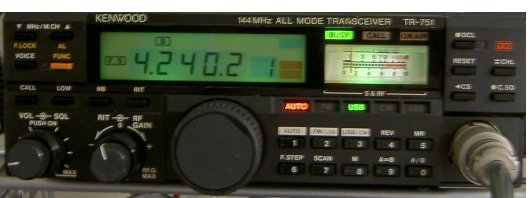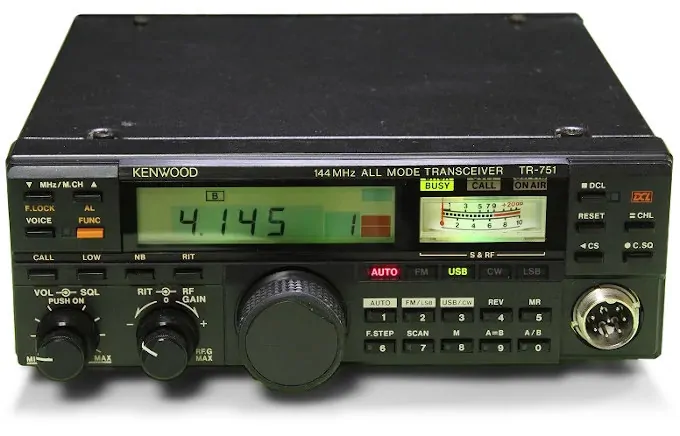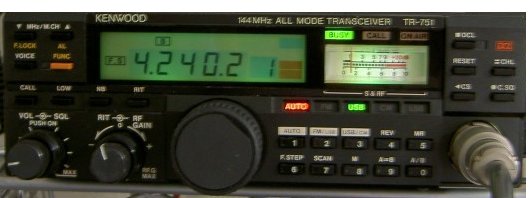
Welcome to our comprehensive review and guide of the Kenwood TR 751A. Whether you are a seasoned ham radio operator or just starting out, this powerful and versatile transceiver is sure to impress. With its wide range of features and exceptional performance, the TR 751A is a must-have for any serious radio enthusiast.
One of the standout features of the Kenwood TR 751A is its impressive power output. With a maximum output of 50 watts, this transceiver provides clear and reliable communication over long distances. Whether you are participating in a contest or simply chatting with fellow operators, the TR 751A ensures that your signal will be heard loud and clear.
Another notable feature of the TR 751A is its wide frequency coverage. With a range of 144-148 MHz, this transceiver allows you to communicate on a variety of bands, making it ideal for both local and long-distance communication. Whether you are interested in VHF FM, SSB, or CW operation, the TR 751A has you covered.
In addition to its impressive performance, the Kenwood TR 751A also offers a range of convenient features. The built-in digital signal processing (DSP) technology enhances audio quality and reduces background noise, ensuring crystal-clear communication. The large, easy-to-read display and intuitive controls make operating the TR 751A a breeze, even for beginners.
Overview of the Kenwood TR 751A
One of the standout features of the Kenwood TR 751A is its dual-band capability. It operates on both the VHF and UHF bands, allowing users to communicate on a wide range of frequencies. This makes it ideal for a variety of applications, including emergency communication, contesting, and general amateur radio use.
The TR 751A offers a power output of up to 50 watts, providing users with plenty of power for long-distance communication. It also features a built-in antenna tuner, which allows for easy tuning and optimization of antenna performance.
In terms of usability, the Kenwood TR 751A features a user-friendly interface and intuitive controls. The front panel includes a large, easy-to-read display, as well as a variety of buttons and knobs for adjusting settings and navigating menus. The radio also includes a built-in speaker, making it convenient for listening to incoming transmissions.
Additionally, the TR 751A offers a range of advanced features, such as dual receive capability, CTCSS and DCS tone encoding/decoding, and memory channel storage. These features enhance the overall functionality of the radio and provide users with greater flexibility and convenience.
In terms of durability and reliability, the Kenwood TR 751A is built to last. It features a rugged construction and high-quality components, ensuring that it can withstand the rigors of regular use. The radio also includes a variety of built-in protection features, such as overvoltage and overcurrent protection, to safeguard against damage.
Features and Specifications
The Kenwood TR 751A is a high-performance amateur radio transceiver that offers a wide range of features and specifications. Whether you are a seasoned ham radio operator or just starting out, this radio has everything you need to communicate effectively.
One of the standout features of the TR 751A is its dual-band capability. It operates on both the VHF and UHF bands, allowing you to access a wide range of frequencies. This makes it a versatile option for a variety of communication needs.
Another notable feature is the radio’s power output. With a maximum power output of 50 watts, the TR 751A provides a strong and clear signal, even over long distances. This makes it ideal for long-range communication or for use in areas with weak signal coverage.
The TR 751A also offers a wide range of modulation modes, including FM, AM, and SSB. This allows you to choose the mode that best suits your communication needs. Whether you are chatting with friends on a local repeater or participating in a DX contest, this radio has you covered.
In terms of reliability, the TR 751A is built to last. It features a sturdy construction and high-quality components, ensuring that it can withstand the rigors of regular use. Additionally, it has a built-in cooling fan to prevent overheating, even during extended operating sessions.
The user interface of the TR 751A is intuitive and user-friendly. It features a large, easy-to-read display and a well-organized control panel. The buttons and knobs are well-placed and responsive, making it easy to navigate through the radio’s various functions and settings.
Performance and Reliability
The Kenwood TR 751A is known for its exceptional performance and reliability. Whether you are a beginner or an experienced ham radio operator, this transceiver will meet all your needs.
In terms of transmit power, the TR 751A offers a maximum output of 50 watts. This ensures that your signals are strong and clear, even when operating at long distances or in crowded bands.
Another aspect that contributes to the performance of the TR 751A is its built-in noise reduction technology. This feature helps to minimize background noise and interference, allowing you to hear your contacts more clearly.
In addition to its performance and reliability, the TR 751A also offers a range of convenient features. These include a built-in speaker, a large LCD display, and a variety of programmable functions. The user-friendly interface and intuitive controls make it easy to navigate through the menu and customize settings according to your preferences.
Overall, the Kenwood TR 751A is a top-notch transceiver that delivers exceptional performance and reliability. Whether you are a seasoned ham radio operator or just starting out, this transceiver will exceed your expectations and enhance your ham radio experience.
User Interface and Controls
The Kenwood TR 751A is equipped with a user-friendly interface and intuitive controls, making it easy for both beginners and experienced operators to navigate and operate the radio.
One of the standout features of the TR 751A is its large, backlit LCD display. The display provides clear and easy-to-read information, including frequency, mode, signal strength, and other important settings. The backlight can be adjusted to suit different lighting conditions, ensuring optimal visibility at all times.
The front panel of the TR 751A is well-organized and logically laid out. The main tuning knob is located on the right side of the radio, allowing for easy frequency adjustments. The volume and squelch controls are conveniently placed on the left side, within easy reach of the operator.
The TR 751A also features a variety of buttons and switches that provide quick access to commonly used functions. These include buttons for selecting the operating mode, adjusting the power output, activating the built-in noise reduction and noise blanker features, and toggling the scanning function.
In addition to the physical controls, the TR 751A also offers a range of menu options that can be accessed through the LCD display. The menu system is intuitive and easy to navigate, allowing users to customize various settings and preferences to suit their individual needs.
For added convenience, the TR 751A includes a built-in speaker on the front panel. The speaker delivers clear and crisp audio, making it easy to hear incoming signals and communications. There is also a headphone jack located on the front panel for private listening.
Overall, the user interface and controls of the Kenwood TR 751A are well-designed and user-friendly. Whether you are a beginner or an experienced operator, you will find it easy to navigate and operate this versatile and reliable radio.
Tips and Tricks for Using the Kenwood TR 751A

1. Familiarize yourself with the user manual: Before using the Kenwood TR 751A, it is essential to read and understand the user manual. This will help you understand the various features and functions of the radio and ensure that you are using it correctly.
2. Use the memory channels: The Kenwood TR 751A has a memory channel feature that allows you to store frequently used frequencies. Take advantage of this feature by programming your most commonly used channels for easy access.
3. Experiment with the different operating modes: The TR 751A supports various operating modes, including FM, AM, and SSB. Experiment with these modes to find the one that works best for your needs and the conditions you are operating in.
4. Adjust the squelch level: The squelch level determines the minimum signal strength required for the radio to unmute and allow audio through. Adjusting the squelch level can help reduce background noise and improve the clarity of incoming signals.
5. Use the built-in noise reduction features: The Kenwood TR 751A has built-in noise reduction features that can help improve the quality of received signals. Experiment with these features to find the settings that work best for your operating environment.
6. Take advantage of the dual VFOs: The TR 751A has dual VFOs (Variable Frequency Oscillators) that allow you to monitor two different frequencies simultaneously. This can be useful for monitoring multiple channels or for performing split-frequency operations.
7. Utilize the built-in CTCSS and DCS tones: The TR 751A supports CTCSS (Continuous Tone-Coded Squelch System) and DCS (Digital-Coded Squelch) tones, which can be used to access repeaters and communicate with specific groups of users. Familiarize yourself with these tones and how to program them into the radio.
8. Keep the radio clean and well-maintained: Regularly clean the exterior of the radio using a soft cloth and mild detergent. Avoid using harsh chemicals or abrasive materials that could damage the radio’s finish. Additionally, perform routine maintenance tasks such as checking the antenna connection and inspecting the battery contacts.
9. Join a local amateur radio club: Joining a local amateur radio club can provide you with a wealth of knowledge and resources for using the Kenwood TR 751A. Club members can offer tips and advice, as well as provide opportunities for hands-on training and operating experiences.
11. Continuously learn and improve: Amateur radio is a hobby that offers endless opportunities for learning and improvement. Take advantage of online resources, books, and other educational materials to expand your knowledge and enhance your operating skills. Attend ham radio events and participate in contests to challenge yourself and gain valuable experience.

Over the years, I have amassed a wealth of experience and knowledge, which I eagerly share with fellow radio aficionados. Through my writing and active participation in the amateur radio community, I strive to inspire others and provide valuable insights into this fascinating hobby. Engaging in various radio activities, I continue to learn and grow, constantly amazed by the endless possibilities that radio communication offers.

